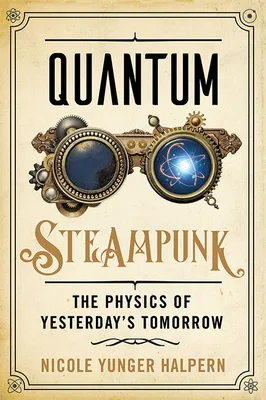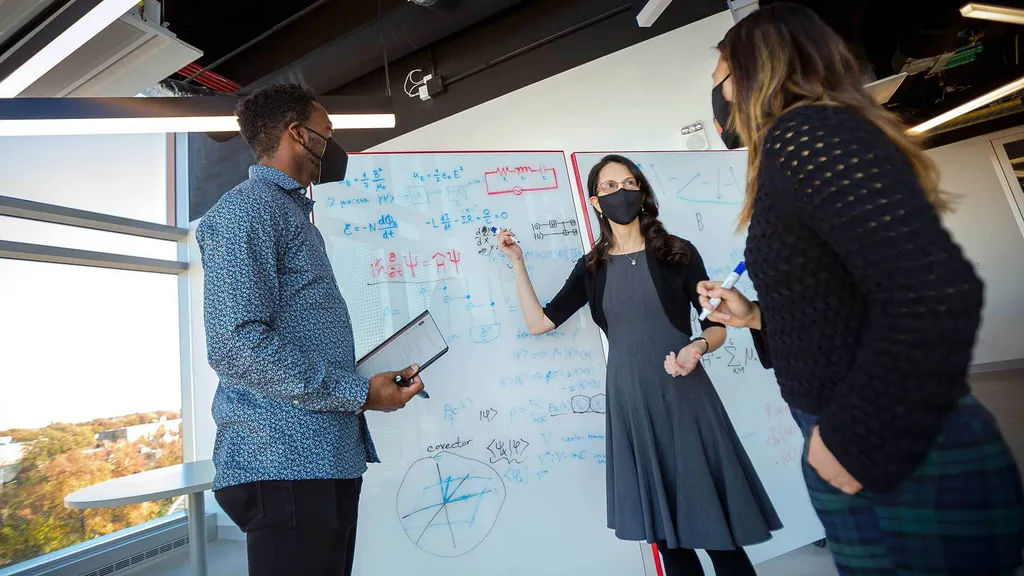- April 12, 2022
- By Chris Carroll
The once-futuristic science of steam engines and airships seems rather quaint these days, at least when stacked up against newer varieties of physics now grabbing the spotlight. (Psst, ever heard of quantum?)
University of Maryland and National Institute of Standards and Technology (NIST) researcher Nicole Yunger Halpern’s theoretical work blends the two eras, examining older questions from the field of thermodynamics—like heat transfer or work output—through the 21st-century lens of quantum information. Applications include quantum engines, even a quantum refrigerator she’s collaborating on with partners in Europe. Not for chilling the ham sandwiches of tomorrow, mind you, but instead using quantum effects to keep a revolutionary new breed of computer processors as frosty as required.

Yunger Halpern’s science and tech focus has a distinctly literary bent. When the adjunct assistant professor in physics and fellow of the Joint Center for Quantum Information and Computer Science was a child and teen, she devoured novel series like “His Dark Materials” and “Chronicles of Chrestomanci,” both part of the steampunk genre blending Victorian and imaginary technologies. She later pursued an educational path embedded in the physical sciences and augmented with history and philosophy. In a new book released today by Johns Hopkins University Press, “Quantum Steampunk: The Physics of Yesterday’s Tomorrow,” she puts a new spin on the concept of quantum thermodynamics, linking the field to the spirit of the novels she grew up on. She even created a cast of fictional characters to illustrate scientific points in a story that runs through the book.
“Like any good quantum system, this book is complex, entangled, and unpredictable,” wrote Caltech theoretical physicist Sean M. Carroll in a prepublication review. He interviewed Yunger Halpern (whose Ph.D. is from Caltech) about the book for his popular podcast, and said she “provides an expert tour of the bustling new research frontier at the intersection of physics, information, and technology, complete with goggles and brass fittings.”
Yunger Halpern, who also has appointments with the Institute for Physical Science and Technology and the University of Maryland Institute for Advanced Computer Studies, spoke with Maryland Today about her blend of science, old and new, with the arts.
So … do the 1890s garb and top hat help while doing calculations?
I must confess that the recent photo shoot was just the second time I had ever dressed up in a steampunk-type costume. The first time was when I was about 5 years old and my family went to a theme park. So no, I don’t dress like that every day, but I do now have that hat in my office.

What does the term “quantum steampunk”—which is part of your lab’s name—actually mean?
Steampunk is generally thought of as a subgenre of science fiction involving Victorian settings: smoky early factories, men in top hats and women in petticoats; and they’re using futuristic technologies like time machines, dirigibles and automatons. So it’s this lovely blend of the old and the futuristic. In the first year of my Ph.D., something clicked, and I realized that the intersection of quantum information and thermodynamics has the same spirit as steampunk. Thermodynamics was developed during the Victorian era so people could, for instance, understand the engines running the factories, and quantum information science is cutting edge and related to futuristic technology. I was delighted as a student of the liberal arts and sciences to find those resonances between a scientific field and a genre of literature and art.
How did you decide to include fictional characters and plotlines in a popular science quantum book?
I actually tried it out in an article I wrote for Scientific American in 2020, which led to this book. I liked the idea of being playful with the conventions of steampunk, and using tropes that often show up in steampunk literature like the spunky, spirited girl who refuses to be quashed by society’s expectations (and corsets), or dark, smoggy London nights. The science-focused readers of the book might not be familiar with those elements, and so I thought it would be something new for them. At the same time, steampunk fans who pick up this book will catch these references, and I hope they find it a fun way to get into the very serious science that makes up the majority of the book.
Quantum books written for lay audiences often break down by chapter two at the latest, and hello, equations. Not yours, however.
I made a decision not to write out equations in the book. You know, when two highly proficient physicists sit down and start talking physics over lunch, they often won't write equations. They will tell each other the basic physics in the form of a story, and that’s what I wanted to do. And of course there is that joke from Stephen Hawking, who said his publisher told him that every equation in the book cuts the number of readers in half.
What’s next for quantum steampunk? For instance, have you considered writing a full-on novel?
I’m currently working with colleagues to strongly build up quantum thermodynamics at the university, and in the University System of Maryland, for both research and outreach. I’d like to hold a short story contest for high schoolers and others, centered on writing quantum steampunk stories. Steampunk is absolutely a genre, and I think it would be cool aesthetically and artistically for quantum steampunk to be a subgenre. I think it would help involve more people in the quantum conversation, which is needed.
As to a novel, if any literary agents read my book and want to suggest I write one, I’d be interested in hearing from them.
